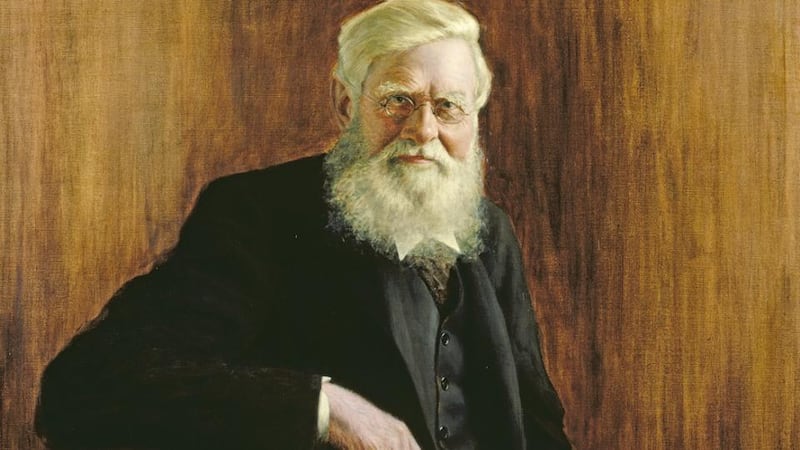In the slow and meticulous resurrection of the “Dead Zoo” — Dublin’s vibrant Victorian Natural History Museum — its million insect specimens have proved a somewhat haunting legacy.
Much of it was built up in the museum’s early years, when new species collected from foreign climes were as eagerly acquired for scientific study as the insects of Ireland’s native provenance. Pinned in tray after tray in wooden cabinets, very few now have an acquisition number or a searchable catalogue entry.
For Dr Aidan O’Hanlon, the museum’s entomology curator, fitting scientific names and origins to strange, exotic insect specimens is a never-ending task. But it can hold exciting surprises. Identifying wasp and bee specimens from the Malayan archipelago, purchased in 1886, he has discovered a collection with distinctive, pale-blue labels used by one of natural history’s greatest figures, Alfred Russel Wallace.
In the theory of evolution, the principle of natural selection is central. This is the process by which species change, adapting to their environment over long periods of time.
READ MORE
The discovery of natural selection is popularly attributed to Charles Darwin. But history records a joint presentation of papers by Darwin and Wallace. And science now accepts that Wallace not only got there entirely independently, but impelled Darwin to publish his masterwork, On The Origin of Species, in 1859.

A superb field naturalist and explorer from Wales, Wallace spent eight years in Malaysia, studying and collecting its exotic bird and invertebrate life. He accumulated an astonishing 125,660 specimens, including 5,000 species new to western science. He sold collections of them to finance his travels.
Fascinated by variations in similar species that were shaped by local geography, he proposed what came to be known as Wallace’s Line, marking a boundary between the animal life of the Australian region and that of Asia.
The workings of natural selection came as a sudden revelation to Wallace, comparable to Darwin’s earlier epiphany among the finches of the Galápagos. He wrote a paper defining the principle and sent it to Darwin, already scientifically famous, seeking his help in publication.
Darwin had held back from publishing his own theories of natural selection, nervous of religious opposition. Now he feared that publication of Wallace’s paper could “shatter my originality”.
After much correspondence (since closely examined for Darwin’s ethical conduct) and mediation by friends, a joint presentation of papers was made to a meeting of London’s Linnean Society under the title “On the Tendency of Species to form Varieties; and on the Perpetuation of Varieties and Species by Natural Means of Selection”.
Scientific response began to weigh in after Darwin’s book appeared a year later. But objections came at once from devout academics in Trinity College Dublin, headed by Samuel Houghton, a priest, mathematician and professor of geology.
Wallace himself had a keen interest in spiritualism. This did him no good scientifically and may have weighed against his share of fame. But Dr O’Hanlon credits him as a leading thinker and “the first scientist to warn of the dangers of deforestation, soil erosion, pollution by factories and biodiversity loss”.
The 400 exotic wasps and bees in his finding of Wallace’s specimens had been passed between Victorian collectors for identification and were bought by the museum at an auction for £15. “The collection,” writes Dr Hanlon in the museum newsletter, “has turned out to be a treasure of scientific and historic importance.”
Three million physical specimens of countless different species, from beetles to sharks, accumulated in the 157 years of the museum’s existence, have been notably valuable to science; biology university students are among its most constant visitors.

A celebrated champion of its collections was the late American palaeontologist and science writer, Stephen Jay Gould. In a widely-quoted essay “Cabinet Museums: Alive, Alive O!” he compared the Victorian approach to displaying nature with that of today’s museums: “You can put one beetle in a cabinet (usually an enlarged model and not a real specimen), surround it with fancy computer graphics and push-button whatsits, and then state no other group maintains such diversity.
“Or you can fill the same cabinet with real beetles from each of a thousand different species — all of differing colours, shapes and sizes ... show everything and incite wonder by sheer variety. But I had never realised how powerfully the decor of the cabinet museum can promote this goal until I saw the Dublin fixtures redone right ... The exuberance is all of one piece — organic and architectural. ”
Gould’s first acquaintance with the museum had been to measure the spread of giant deer antlers. In 1971, this meant kneeling in thick dust on top of glass cabinets. “My, oh my,” he wrote later, “the museum was a dingy place back then.”
He was subsequently to praise the interior renovations of the 1990s that uplifted it “from squalor to glory” — a job of wholesale restoration that we now see in progress again.












